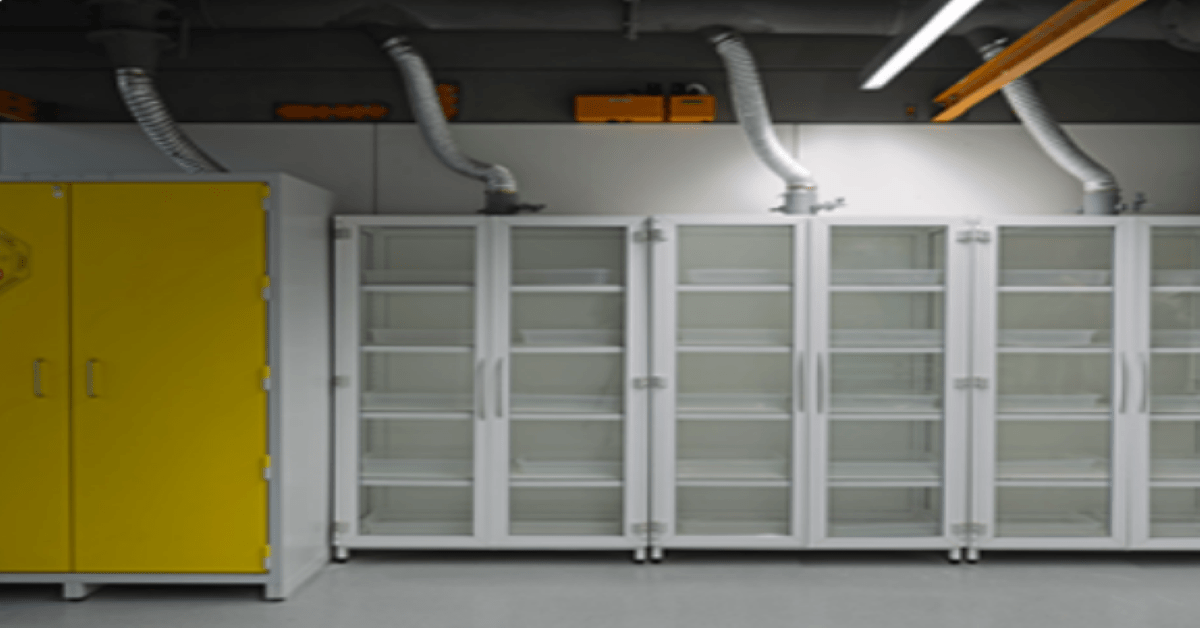Several types of chemicals are expected to be stored in a laboratory. Those chemicals need proper storage logic and safety. Chemicals by themselves pose independent hazards; if noncompatible ones interact with each other, the hazards are many folds higher.
Before choosing the right chemical storage cabinet, an overall storage strategy must be chalked out. Apart from the users of the Lab and its planners, team members from engineering/ maintenance, safety, and materials should be involved in planning those storages and ensuring adherence to the applicable standards.
Understand your chemicals thoroughly
Chemicals have different characteristics. Apart from broad groups such as Acids, Bases, Flammables, Explosives, Pyrophorics, Pesticides, Toxins, etc. It is important to store chemicals as per their groups. Non-compatible group chemicals mustn’t be stored together. MSDS (material safety data sheet) for each chemical must be available and easily accessible. GHS (Globally Harmonized System) Pictograms on chemical containers help us understand risks at a glance. Specified storage conditions should be clearly understood and well communicated to all stakeholders. Physical characteristics such as Boiling Point, Flash Point, etc also need attention.
Understand the chemical storage safety standards
It is important to follow your organization’s safety standards. There are US standards such as NFPA 30 Chapter 9.5.3 and OSHA 29 CFR 1910.106 and rated as per FM or UL for flammables. The European standard is EN 14470-1 for flammables. Your laboratory chemical storage strategy must be in line with the overall safety strategy and philosophy of your organization.
With the preparatory work done as discussed, you are now ready to select the right storage cabinet(s) for each group of chemicals:
Explosive Chemicals
As a rule, Explosive Chemicals must not be stored in your lab. The EHS (Safety) arm of your organization will work on this need.
Pyrophorics/Water Reactive
These might need dedicated refrigerated storage. It may also be necessary to store it in an inert atmosphere. Involve the EHS (Safety) arm of your organization.
Flammable and Combustible Liquids
Storage cabinets for these chemicals are made of epoxy-coated steel. They are painted Yellow. A flammable liquids storage cabinet must protect the volatile content inside for at least 10 minutes to meet US OSHA and NFPA standards. These cabinets are double-walled for fire resistance. It could have manual or self-closing doors. For more stringent requirements, you may choose a cabinet with European (EN) standards. These protect the volatile content inside for 30 or 90 minutes depending on the models. These cabinets come in 4 to 90 gallons capacities and internal configurations. Flammable storage cabinets must never be ventilated.
Paints and Inks (often in aerosols) are stored in similar cabinets, which could be Yellow or Red painted. Those come with suitable internal configurations.
Acids and Corrosive Chemicals
These cabinets, painted Blue are designed to keep non-flammable Corrosive chemicals and Acids. Made of steel or Polyethylene, their construction offers superior resistance to spills and vapors. Polyethylene or Polypropylene cabinets are selected for aggressive Sulfuric, Nitric, or Hydrochloric Acid. However, if the corrosive chemicals are flammable as well, they must be stored only in a flammable storage cabinet.
These cabinets come in different sizes. It is possible to fit them below a fume hood, countertops, and lab work benches. They could be stand-alone types as well. In some cases, these cabinets can have forced air circulation and filtered extraction of vapors.
Solvents and Organic Chemicals
These chemicals demand the extraction of pent-up fumes inside the cabinets. Accordingly, Solvent storage cabinets are available. Made in powder-coated steel with glass doors for better visibility they come in different sizes and features. At times these cabinets are ventilated either outside the lab or within the lab through a carbon filter.
Pesticides and Insecticides
These are toxic chemicals and there are corrosives. Typically painted Green these cabinets are made of powder-coated steel and may have manual or self-closing doors. Internal configuration in molded polyethylene shelves compliments the exterior design.
General Non-Hazardous Chemicals
These groups of chemicals whether in liquid or powder form need proper storage. The storage conditions are less stringent still proper access and visibility are required. Steel/ Wood construction can be suitable for these chemicals.
We at LabGuard, are just a call away to understand and recommend the right chemical storage cabinet for your application. It could be a part of your overall lab project or even the need for a stand-alone chemical storage cabinet. Do get in touch.
Table: Standards for Flammable Chemical Storage Cabinets
| American | NFPA 30 | Chapter 9.5.3 | UL/FM |
| OSHA 29 | CFR 1910.106 | UL/FM | |
| European | EN | 14471, 14472 | 60/90 min |
| EN ISO | 14001 | 60/90 min | |
| EN | 1621/1622 | 60/90 min |


